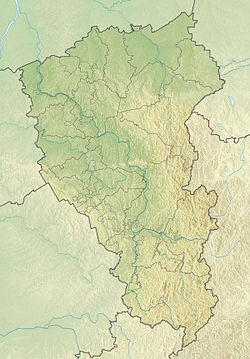| Ilek Formation | |
|---|---|
| Stratigraphic range: Lower Cretaceous, Barremian–Aptian | |
 Shestakovo 1 locality | |
| Type | Geological formation |
| Unit of | Kiya River Basin |
| Underlies | Kiya Formation |
| Overlies | Tyazhin Formation |
| Thickness | Up to 746 metres (2,450 ft) |
| Lithology | |
| Primary | Clay, siltstone |
| Other | Marl, sandstone |
| Location | |
| Coordinates | 55°54′N 88°00′E / 55.9°N 88.0°E |
| Approximate paleocoordinates | 54°12′N 84°36′E / 54.2°N 84.6°E |
| Region | Western Siberia |
| Country | |
| Extent | |
| Type section | |
| Named by | L. A. Ragozin |
| Year defined | 1935 |
The Ilek Formation is a Lower Cretaceous geologic formation in Western Siberia. Many different fossils have been recovered from the formation. It overlies the Late Jurassic Tyazhin Formation and underlies the Albian Kiya Formation.[1]
The formation was described by L. A. Ragozin in 1935. It consists of sands with sandstone concretions, layers of silts, clays and marls.[2] Age of the formation, according to a crude 1962 estimate, is Valanginian(?) - Hauterivian - Barremian. Its thickness varies greatly, reaching 746 m in Teguldet borehole.[3] A more recent 2024 estimate based on invertebrate and vertebrate fossils placed the age of the formation at Barremian–Aptian.[4]
- ^ Cite error: The named reference
Golovneva2010was invoked but never defined (see the help page). - ^ Cite error: The named reference
dict_1955was invoked but never defined (see the help page). - ^ Cite error: The named reference
Lebedev_1962was invoked but never defined (see the help page). - ^ Cite error: The named reference
Ivantsov2024was invoked but never defined (see the help page).

